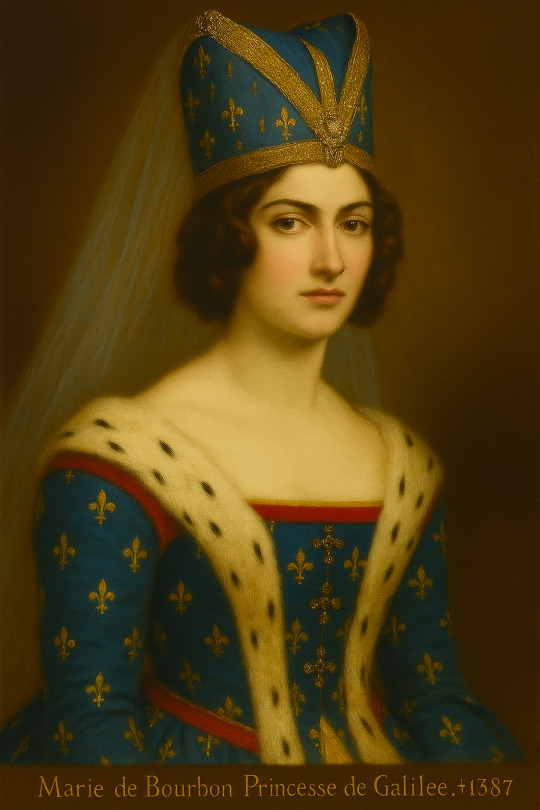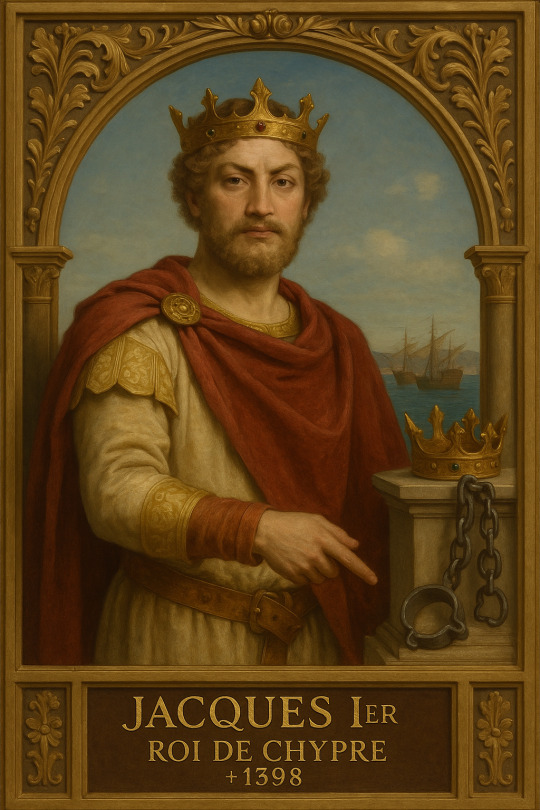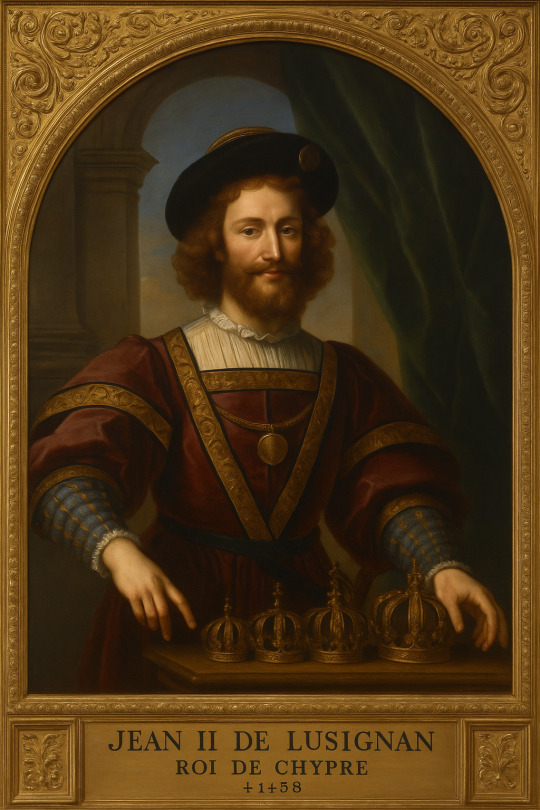Text

Guy de Lusignan (1275-1303), Prince and Constable of Cyprus.
He was the youngest son of Hugh III of Cyprus (ruled in 1267–1284) and Isabella of Ibelin.
In 1303, Guy conspired against his brother Henry II of Cyprus. Discovered, he was executed the same year.
He was the father of King Hugh IV of Cyprus.
#kingdom of cyprus#house of poitiers lusignan#guy of lusignan#constable of cyprus#royaume de chypre#guy de chypre#guy de lusignan#maison de lusignan#maison de poitiers lusignan#connétable de chypre#prince de chypre#equestrian portrait
0 notes
Text

Eschiva of Ibelin (1253-1312) was Lady of Beirut in 1282–1312. She was the daughter of John II of Beirut (died 1264), lord of Beirut, and of Alice de la Roche.
Eschive d'Ibelin married Humphrey de Montfort, lord of Tyre in 1274. He died in 1284.
After Humphrey's death in 1284, in 1291 Eschive married Guy of Lusignan, constable of Cyprus (died 1302).
#kingdom of cyprus#kingdom of jerusalem#house of ibelin#eschiva of ibelin#lady of beirut#lordship of beirut#kingdom of heaven#crusades#royaume de jérusalem#outremer#Echive d'Ibelin#Dame de Beyrouth#beirut#beyrouth#salle des croisades#Seigneurie de Beyrouth
2 notes
·
View notes
Text

Hugh IV (1293/96-1359) was King of Cyprus from 31 March 1324 to his abdication, on 24 November 1358 and, nominally, King of Jerusalem, as Hugh II, until his death.
He was the son of Guy, Constable of Cyprus (son of Hugh III of Cyprus), and Eschiva of Ibelin.
Hugh's reign is poorly recorded in historical sources and so he remains a little-known figure. Visitors to his island kingdom thought him pious and just, but his son-in-law portrayed him as a vicious tyrant.
#kingdom of cyprus#hugh iv#king of cyprus#house of poitiers lusignan#royaume de chypre#hugues iv#roi de chypre#vive le roi#maison de poitiers lusignan
0 notes
Text

Alice of Ibelin (1304-1386) was Queen consort of Cyprus and nominal Queen consort of Jerusalem as the second wife of King Hugh IV of Cyprus. Two of her sons, Peter and James, reigned as kings of Cyprus.
#kingdom of cyprus#queen consort#alix of ibelin#house of ibelin#queen of cyprus#queen of jerusalem#kingdom of heaven#royaume de chypre#alix d'ibelin#reine consort#vive la reine#royaume de jérussalem#maison d'ibelin
0 notes
Text

Guy of Lusignan (1316-1343) was constable of Cyprus and titular Prince of Galilee.
He was the eldest son of King Hugh IV of Cyprus and his first wife Maria of Ibelin, who was the daughter of Guy, count of Jaffa.
Around 1320, Guy inherited the principality of Galilee from his mother's family.
In 1338 Guy was appointed as constable of Cyprus. He died in the summer of 1343, as can be deduced from the condolence letter from Pope Clement VI dated 24 September 1343.
#kingdom of cyprus#house of poitiers lusignan#principality of galilee#guy of lusignan#prince of galilee#crusades#royaume de chypre#principauté de galilée#guy de lusignan#prince de galilée#maison de lusignan#maison de poitiers lusignan#portrait
0 notes
Text

Marie de Bourbon (1315-1387) was a daughter of Louis I, Duke of Bourbon and Mary of Avesnes. She was a younger sister of Peter I, Duke of Bourbon and an older sister of James I, Count of La Marche.
She married to Guy of Lusignan, titular Prince of Galilee on 31 January 1330. He was the son of Hugh IV of Cyprus and his first wife Marie d'Ibelin.
Hugh of Lusignan, their only known son, was born in about 1335 and her husband died in 1343 from unstated causes.
In 1346, Marie and her son left Cyprus in exile. By 1347, they had settled in Naples, Kingdom of Naples, at the court of Queen Joan I of Naples. On 9 September 1347, Marie married her second husband Robert of Taranto, a first cousin, once removed to Joan. Her new husband was the claimant to the throne of the Latin Empire while holding both the Principality of Taranto and the Principality of Achaea...
#kingdom of cyprus#principality of achaea#principality of galilee#crusades#latin empire#house of bourbon#royaume de chypre#maison de bourbon#principauté de galilée#princesse de galiliée#portrait#marie de bourbon#salle des croisades
0 notes
Text

Hugh de Lusignan (1335-1385) was titular Prince of Galilee (as Hugh III) and claimant to the Kingdom of Cyprus. He was the son of Guy of Lusignan heir to the throne of Cyprus and Prince of Galilee, and his wife Marie of Bourbon, daughter of Louis I, Duke of Bourbon.
With the dead of his father in 1343, Marie wanted to return to the West with her son. With the pressure of Pope Clement VI, she succeeded in convincing the King to let them leave the Kingdom in the spring of 1347.
In Cyprus, the old King Hugh IV finally settled the matter of his succession. In November 1358, during his lifetime, he had his second son Peter, (then Count of Tripoli) crowned as King in Nicosia by the Bishop of Limassol. Hugh was thus disinherited by this action.
Hugh of Lusignan served the Papacy in Italian affairs and became a Senator of Rome in 1361. In 1363, he married Joan of Durazzo, a wealthy Neapolitan heiress.
In1365, Hugh of Lusignan participated in Peter I's Alexandrian Crusade during which he distinguished himself. In October he witnessed the capture of Alexandria by the royal armies. It was on this occasion that the King granted him the title of Prince of Galilee, which had formally been held in his paternal grandmother's family.
He died on Cyprus in 1385, and was buried in the Church of Saint Dominic in Nicosia, without children.
#kingdom of cyprus#prince of galilee#house of poitiers lusignan#hugh of lusignan#principality of galilee#kingdom of heaven#latin kingdom of jerusalem#crusades#kingdom of jerusalem#royaume de chypre#hugues de lusignan#prince de galilée#principauté de Galilée#maison de poitiers lusignan#salle des croisades
12 notes
·
View notes
Text

Peter I (1328-1369) was King of Cyprus and titular King of Jerusalem from his father's abdication on 24 November 1358 until his death in 1369. He was invested as titular Count of Tripoli in 1346. As King of Cyprus, he had some military successes, but he was unable to complete many of his plans due to internal disputes that culminated in his assassination at the hands of three of his knights.
He tried to convince powerful rulers to strengthen him by organizing a crusade to liberate the Holy Land and the Kingdom of Jerusalem which belonged to him. He travelled to England, Germany, and France. During his visit in England the historical Banquet of the Five Kings took place.
Peter returned to Cyprus, but was rapidly plunged into domestic troubles. Queen Eleanor had been unfaithful during his long absences in Europe, and he retaliated by tyrannizing her favorite nobles, alienating his brothers. On 17 January 1369 he was assassinated in his bed at the Palace of La Cava, Nicosia.
Despite the harshness that brought a premature end to his life, his knight-errantry and crusading zeal led him to be regarded as the epitome of chivalry. He was buried in the church of St. Dominic's of Nicosia, the traditional burial place of the Kings of Cyprus. He was succeeded by his son Peter II.
#latin kingdom of jerusalem#kingdom of cyprus#kingdom of jerusalem#kingdom of heaven#crusades#peter i#king of cyprus#king of jerusalem#count of tripoli#house of poitiers lusignan#outremer#royaume de chypre#royaume de jérusalem#roi de chypre#roi de jérusalem#comte de tripoly#vive le roi#chevalier#croisades#salle des croisades#portrait#maison de poitiers lusignan
2 notes
·
View notes
Text

Eleanor of Aragon (1333-1416) was Queen consort of Cyprus by marriage to Peter I of Cyprus.
She was regent of Cyprus during the absence of her spouse in 1366, and regent during the minority of her son Peter II of Cyprus from 1369. It is known that Eleanor did not get along with her daughter-in-law Valentina due to being involved in many issues and scandals.
In 1381, the now 44-year-old Eleanor was forced to return to Catalonia, in order to prevent more problems with Valentina.
#house of barcelona#eleanor of aragon#latin kingdom of jerusalem#kingdom of cyprus#kingdom of heaven#queen consort#queen of cyprus#royaume de chypre#royaume de jérusalem#reine de chypre#vive la reine
1 note
·
View note
Text

Peter II of Cyprus (1354 or 1357–1382), called the Fat, was the eleventh King of Cyprus of the House of Lusignan from 1369 until his death.
He succeeded to the throne while he was still under age, following the assassination of his father in 1369. He was also titular Count of Tripoli and King of Jerusalem.
Peter II, who had no surviving children, was succeeded not by his surviving sister Marie, called Mariette, nor by their oldest uncle, John of Lusignan, who had been murdered in 1375, but by his younger uncle, who became James I of Cyprus.
#kingdom of cyprus#latin kingdom of jerusalem#county of tripoli#kingdom of jerusalem#peter ii#king of cyprus#count of tripoli#royaume de chypre#royaume de jérusalem#pierre le gros#roi de chypre#vive le roi#maison de poitiers lusignan#house of poitiers lusignan#comte de tripoli
0 notes
Text

Valentina Visconti (1357-1393) was Queen consort of Cyprus and titular Queen consort of Jerusalem by marriage to Peter II of Cyprus.
Peter and Valentina had one daughter who died at the age of two in Nicosia in 1382.
It is known that Valentina did not get along with her mother-in-law Eleanor of Aragon due to her being involved in many issues and scandals.
#kingdom of cyprus#latin kingdom of jerusalem#kingdom of jerusalem#kingdom of heaven#house of visconti#visconti#milan#crusades#house of poitiers lusignan#royaume de chypre#royaume de jérusalem#valentina visconti#queen of cyprus#queen of jerusalem#queen consort#vive la reine#reine consort#maison de poitiers lusignan
0 notes
Text

James I of Cyprus (1334-1398) was the youngest son of King Hugh IV of Cyprus and by 1369 held the title "Constable of Jerusalem." When his nephew Peter II died in 1382, he became King of Cyprus. James was also crowned King of Jerusalem in 1389 and assumed the title of King of Armenia in 1393, which was formally given to him in 1396.
#kingdom of cyprus#latin kingdom of jerusalem#kingdom of armenia#kingdom of jerusalem#Armenian Kingdom of Cilicia#house of poitiers lusignan#royaume de chypre#royaume d'armenie#royaume de jérusalem#maison de poitiers#maison de poitiers lusignan#Jacques de Lusignan#roi de chypre#vive le roi
0 notes
Text

Helvis of Brunswick-Grubenhagen (1353–1421) was the queen consort of Cyprus and titular queen consort of Armenia as the wife of King James I of Cyprus. She was styled Queen of Cyprus from 1382 to 1398; although at the time of his ascension to the Cypriot throne, she and James were imprisoned in Genoa after they had been captured by the Genoese on the island of Rhodes. Almost all of Helvis 11 children were born to her while she was held prisoner. In 1385, after negotiations and many ruinous concessions to the Genoese, they were released and James was crowned king. In 1393, she became Queen of Armenia.
#kingdom of cyprus#latin kingdom of jerusalem#kingdom of armenia#kingdom of jerusalem#helvis of brunswick grubenhagen#queen of cyprus#queen consort#house of brunswick#royaume d'armenie#royaume de chypre#royaume de jérusalem#reine consort#vive la reine#crusades#outremer#house of welf
0 notes
Text

Janus of Cyprus (1375-1432) was King of Cyprus and titular King of Armenian Cilicia and Jerusalem from 1398 to 1432.
Janus was born in Genoa, where his father, James I of Cyprus, was a captive. When his father was elected king, he negotiated an agreement with the Genoese to release him to go to Cyprus, which he signed on 2 February 1383. Under that agreement, the Genoese were given new commercial privileges. However, the Genoese demanded that his father leave his son Janus in their city as a hostage.
After his father's death on 9 September 1398, Janus took over the throne of Cyprus.
The island was affected by epidemics in 1408. Simultaneously, there were many raids of locusts on the island, which caused destruction to agriculture. A new epidemic arrived in 1419–20, which probably caused the death of Janus' second wife, Charlotte on 15 January 1422.
Meanwhile, because Cyprus was still a permanent base of campaign for pirates and adventurers, after raids around the Cypriot coasts, Janus had repeated discussions with the Sultan of Egypt via the sultan's representatives. Janus was unable to stop the raids, which gave the Muslims a reason to attack Cyprus.
Following the Battle of Chirokitia (7 July 1426) against the Mamluks, King Janus was captured by the Egyptian forces. He was ransomed after ten months of captivity in Cairo.
Janus was humiliated in Cairo: they took him, tied up with chains and riding a donkey, in front of the sultan, after which he was forced to kneel and worship nine times the soil on which he stepped. The release of Janus was effected after the intervention of Europeans, who collected money for the required ransom. Cyprus also had to offer the sultan an annual tax based on income from 5,000 duchies. This tax continued to be paid even after the end of Frankish rule in Cyprus. Together with Janus, some of the captives managed to buy their freedom after their families collected money to ransom them.
#Armenian Kingdom of Cilicia#Lesser Armenia#Little Armenia#Կիլիկիոյ Հայկական Թագաւորութիւն#latin kingdom of jerusalem#kingdom of cyprus#kingdom of jerusalem#king of cyprus#king of jerusalem#king of armenia#house of poitiers lusignan#outremer#janus de chypre#royaume d'armenie#royaume de chypre#vive le roi#crusades#royaume de jérusalem#Battle of Chirokitia
0 notes
Text

Anglesia Visconti (1377-1439) was a queen consort of Cyprus by marriage to King Janus. After her marriage Anglesia was renamed Heloise. The marriage was annulled between 1407 and 1409 without issue.
#kingdom of cyprus#latin kingdom of jerusalem#kingdom of heaven#kingdom of jerusalem#kingdom of armenia#queen consort#house of lusignan#royaume de chypre#royaume d'armenie#royaume de jérusalem#reine consort#visconti#vive la reine#milan#outremer#house of visconti
0 notes
Text

Charlotte of Bourbon-La Marche (1388-1422) was the queen consort of Cyprus and titular queen consort of Armenia and Jerusalem through her marriage to King Janus. She was his second wife and the mother of his six legitimate children, which included King John II and Anne de Lusignan. It was Charlotte's influence which was instrumental in the revival of French culture at the royal court in Nicosia.
#royaume de chypre#outremer#reine consort#reine de chypre#vive la reine#maison de bourbon#bourbon la marche#maison de lusignan#maison de poitiers lusignan#kingdom of cyprus#latin kingdom of jerusalem#kingdom of armenia#kingdom of heaven#kingdom of jerusalem#queen consort#house of lusignan#house of bourbon#Regnum Cypri
1 note
·
View note
Text

John II of Cyprus (1418-1458) was the King of Cyprus and Armenia and also titular King of Jerusalem from 1432 to 1458. He was previously a titular Prince of Antioch.
His reign was marked by a progression of Greek influence, which had been eclipsed by the Latin element for almost two and a half centuries, first under pressure from his second wife, Helena Palaeologus, and then because, after the fall of Constantinople in 1453, many Greek nobles took refuge in Cyprus.
#latin kingdom of jerusalem#kingdom of cyprus#kingdom of jerusalem#kingdom of armenia#kingdom of heaven#house of Lusignan#house of poitiers lusignan#principality of antioch#royaume de chypre#royaume de jérusalem#royaume d'armenie#jean ii#roi de chypre#roy de jérusalem#vive le roi#roi d'armenie#maison de lusignan#maison de poitiers lusignan
1 note
·
View note